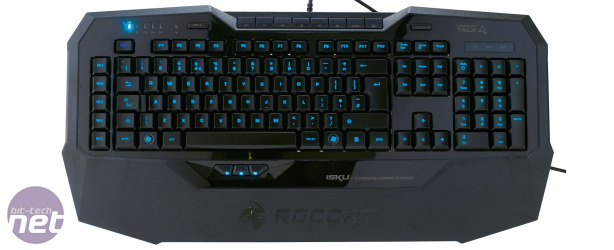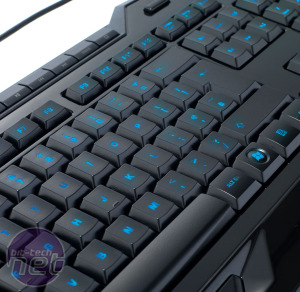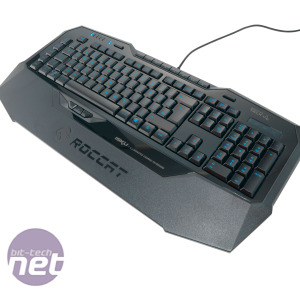
Roccat Isku Review
Manufacturer: RoccatUK price (as reviewed): £71.99 (inc VAT)
US price (as reviewed): $119.99 (ex tax)
The Roccat Isku’s main feature isn’t its macro keys, funky backlighting or any of the usual gaming keyboard hyperbole. That’s not to say the Isku lacks these features – it’s just that this is the first keyboard to support Roccat’s Talk technology, which enables it to control the functions of a Talk-compatible mouse.
At the moment, that’s limited to the uninspiring Roccat Kone+, so we had no choice but to use this to test the Isku’s Talk features. Talk’s main advantage is the ability to use a keyboard button to change settings on the mouse. For example, you can map a key press (or pairing) to change mouse profiles instantly. Even more useful is the ability to change the sensitivity of the mouse with a keyboard keystroke rather than having to stretch a finger towards an awkwardly placed secondary button.
Setting up a key binding is a bit of a faff, especially if you want a key to work as a toggle rather than having to hold it down, but we were able to set up some Talk functions fairly quickly. Changing the mode switches the mouse’s lights to the appropriate colour, and holding the M1 macro key to reduce the dpi sensitivity was a lot easier than scrabbling our fingers around the mouse’s small body.
However, despite its Talk technology, the Isku is unpleasant to use. The keys feel cheap and loose, and they also lack responsiveness. The backlight caused trouble too, as the light doesn’t bleed into the key markings particularly well. When viewed from any reasonable typing angle (rather than absolutely perpendicular) the lettering appeared fuzzy, with the tops of letters disappearing altogether.
This is less of a problem for touch-typists, but even we don’t know where the ‘~’ key usually lives, or whether the per cent symbol is above the 4 or the 5 key, so we found ourselves constantly peering over the top of the keyboard to read the symbols.
It doesn’t help that the backlight turns itself off after a period of inactivity. The attractive, if cluttered, software lets you set the time-out period and the level of intensity to which the backlight will drop, but even though we set a level of 100 per cent brightness, the backlight still turned itself off. This meant an extra key press every time we took a break from our PC.
At least the macro keys are in a useful position. The three keys below the Space Bar are easy to press with the side of your thumb. There are five more on the left of the main key area, labelled M1-5, and a record button above F3. Above the standard keys there’s also a row of media control buttons, and a backlight control button to the right of this. You can choose from six brightness levels, although one of those is no brightness at all, which makes the keyboard very hard to use for non-touch-typists.
While the shape and size of the Isku is appealing, there’s a fair bit of bend in the body too. As with all recent Roccat peripherals, the USB plugs are at least labelled with the model name, making it easy to know what you’re unplugging.
Conclusion
While Roccat’s aim of shifting fiddly mouse controls to a keyboard is a good idea, the Isku is unpleasant to use thanks to its flimsy build quality and poor key action. What's more, the only mouse that currently supports Roccat Talk is the lacklustre Kone+. Talk has potential, but it deserves better-quality devices than the Isku and Kone+ to see it reach it.-
Value10 / 25
-
Features28 / 35
-
Design18 / 40


MSI MPG Velox 100R Chassis Review
October 14 2021 | 15:04











Want to comment? Please log in.